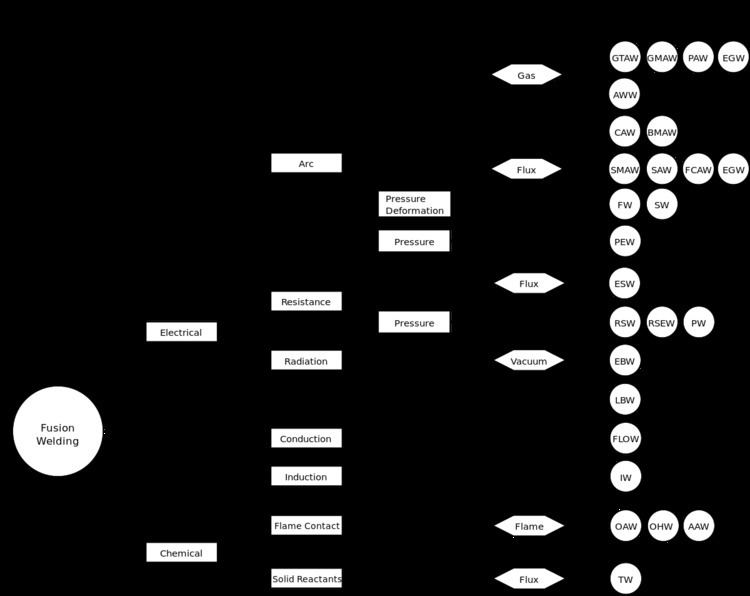 | ||
Fusion welding is a generic term for welding processes that rely upon melting to join materials of similar compositions and melting points. Due to the high-temperature phase transitions inherent to these processes, a heat-affected zone is created in the material:755 (although some techniques, like beam welding, often minimize this effect by introducing comparatively little heat into the workpiece).
Contents
In contrast to fusion welding, solid-state welding does not involve the melting of materials.
Applications
Fusion welding was a key factor in the creation of modern civilization. It is also very important for maintaining civilization. Fusion welding holds a key role in construction. Besides bolts and rivets there are no other practical method for joining pieces of metal securely. Fusion welding is used to make many everyday items. From construction to airplanes to cars fusion welding is very common. Another common use of fusion welding is in artwork. There is a large community that uses both arc and flame contact welding artwork.
Arc
Arc welding is one of the many types of fusion welding. Arc welding joins two pieces of metal together by using an intermediate filler metal. The way this works is by completing an electrical circuit to create an electrical arc. This electrical arc is 6500oF in its center. This electrical arc is created at the tip of the filler metal. As the arc melts the metal it is moved either by a person or a machine along the gap in the metals creating a bond. This method is very common as it is typically done with a hand held machine. Arc welding machines are portable and can be brought on to job sites and in hard to reach areas. Arc welding is also the most common method of underwater welding. Electrical arcs form between points separated by a gas. In the process of underwater welding a bubble of gas is blown around the area being welded so that an electrical arc may form. Underwater welding has many applications. Ship hulls are repaired and oil rigs are maintained with underwater arc welding.
Resistance welding is done using two electrodes. Each electrode comes into contact with one of the pieces being welded. The two pieces of metal are then pressed together between the electrodes. While they are being pressed an electric current is ran through them. As this happens the pieces of metal begin to heat up at the point where they come into contact. The current is passed through the metal until it is hot enough to the point where the two pieces melt and conjoin. As the metal cools the bond is solidified. This process requires large amounts of electricity. In most cases transformers are needed to provide enough Amps. Resistance welding is a very prevalent form of fusion welding. Resistance welding is used in the manufacturing of automobiles and construction equipment.
Laser Beam Welding
Conduction welding also known as laser welding or radiation welding is a highly precise form of fusion welding. Laser is an acronym for Light Amplification by Stimulated Emission of Radiation. The laser emits light in bursts called pumps. These bursts are aimed at the seam of the metals desired to be conjoined. As the laser bursts it is guided along the seam. These intense bursts melt the metal. The two metals when melted mix with each other. Once it has cooled the seam created is a strong bond. Lasers are efficient because they can be configured to make multiple welds at once. The laser beam can be split and sent to multiple locations greatly reducing the cost and amount of energy required. Laser beam welding finds applications in the automotive industry.
Induction
Induction welding is a form of resistance welding. In induction welding however there are no points of contact between the metal being welding and the electrical source or the welder. In induction welding a coil is wrapped around a cylinder. This coil causes a magnetic field across the surface of the metal inside. This magnetic field flows in the opposite direction of the magnetic field on the inside of the cylinder. These magnetic flows impede each other. This heats up the metal and causes either the damaged or separate edges to melt together.
Oxyfuel
Flame contact welding is a very common form of welding. The most popular kind of flame contact welding is oxyfuel gas welding. Flame contact welding uses a flame exposed to the surface of the metals being welded to melt and then join them together. Oxyfuel uses oxygen as a primary ignition source in tandem with another gas such as acetylene to produce a flame which is 2500oC at the tip and 2800-3500oC at the tip of the inner cone. Other gasses such as propane and methanol can be used for oxyfuel welding. Acetylene is the most common gas used in oxyfuel welding.
Solid Reactant
Solid reactant welding uses reactions between elements and compounds. Certain compounds when mixed create an exothermic chemical reaction, meaning they give off heat. A very common reaction uses is thermite. Thermite is a combination of a metal oxide (rust) and aluminum. This reaction produces heat over 4000oF. Solid reactant compounds are channeled to the two pieces of metal being joined. Once in place a catalyst is used to start the reaction. This catalyst can be a chemical or another heat source. The heat created melts the metals being joined. Once it cools a bond is formed. Solid reactant has been used throughout history. From welding together train tracks to entering banks vaults it has many niche uses.
